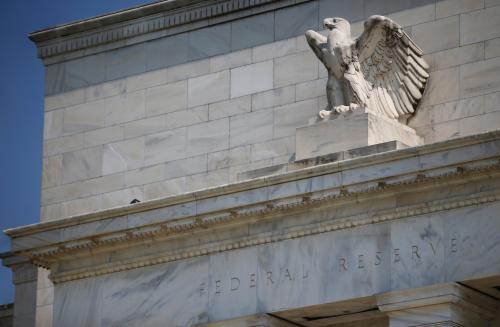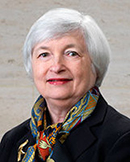These remarks were presented at the Fall 2018 conference of the Brookings Papers on Economic Activity for a symposium on the effective lower bound. You can read remarks from the other panelists here.
I’d like to thank the organizers for inviting me to offer thoughts on a significant issue facing the Federal Reserve in the coming years—namely, how to provide the accommodation the economy needs to recover from future downturns.
This issue is important because constraints on the setting of short-term rates due to the zero (or effective) lower bound on interest rates may well bind more often in the future than they have in the past. Michael Kiley and John Roberts, in a recent Brookings Paper[1] showed that the zero bound would constrain monetary policy 40 percent of the time if the neutral nominal short rate is 3 percent and the FOMC conducts policy by following a standard monetary policy rule, such as the Taylor Rule. The consequence would be poor economic performance with significant shortfalls in output and employment during zero lower bound episodes. In addition, with inflation averaging around 2 percent when the zero lower bound does not bind and often declining below 2 percent when it does, inflation, on average, will fall short of the FOMC’s 2 percent target. Such a persistent inflation shortfall could erode inflation expectations over time, compounding the zero lower bound constraint by lowering the normal nominal short rate consistent with any given neutral real rate.
The increased relevance of the zero lower bound reflects the fact that the neutral real rate of interest (r*) looks to have declined considerably in recent decades while inflation expectations have become well anchored around the FOMC’s 2 percent target. There is a good deal of uncertainty about both the current magnitude and future evolution of r*. Empirical estimates are sensitive to methodology. A key paper by Laubach and Williams[2], however, finds that r* is currently only slightly above zero. And FOMC participants estimate that the longer-run normal real fed funds rate is only a little higher, with the median estimate of r* between 0.75 percent to 1 percent. The causes of the decline in r*, which is also evident in other advanced economies, are uncertain, but look to be structural and persistent. They include low productivity growth, declining trend labor force growth reflecting aging societies and an increased preference for safe assets.
To improve economic performance, the FOMC could consider a number of approaches. Some involve the deployment of unconventional tools, such as longer-term asset purchases, interventions to directly target longer-term yields (similar to the Bank of Japan’s yield curve control approach); and negative nominal interest rates. Other approaches, such as raising the inflation target or adopting price or nominal GDP targeting entail a change in policy goals. I have argued that asset purchases worked and should remain in the Fed’s toolkit. But that tool will not likely fully alleviate the zero lower bound problem. The other approaches that I mentioned deserve study and debate, but I see considerable disadvantages with each of them. Their shortcomings were recently summarized by my colleague Ben Bernanke in a paper presented at last year’s Rethinking Macro Conference[3]. I agree with his assessments and, given my time constraints today, I will instead focus on an approach I consider promising—one that is evolutionary, practical, and has the potential to significantly mitigate the adverse effects of the zero lower bound.
I believe the FOMC should seriously consider pursuing a lower-for-longer or makeup strategy for setting short rates when the zero lower bound binds and should articulate its intention to do so before the next zero lower bound episode. The phrase “lower for longer” is due to David Reifschneider and John Williams who, in a 2000 paper[4] suggested that the Fed, during a zero lower bound period, could keep track of the cumulative deviations of short rates from the recommendations of a simple rule (the Taylor rule) and then “work off” or “make up” these accommodation shortfalls over time by holding short rates lower for longer than the rule would recommend. Under this strategy, the average level of short rates over a period of say ten years from the onset of a zero lower bound episode would be essentially unaffected by the zero lower bound constraint. If the strategy is understood and credible, it should cause long-term rates to decline when the zero lower bound begins to bind by about as much as would occur in the absence of any effective lower bound at all—that is if the FOMC could set negative rates. Under the empirically reasonable assumption that what matters for aggregate spending is the entire expected path of short-term rates rather than just the current level, this strategy enables the Fed to provide substantial additional accommodation during zero lower bound episodes. The strategy also potentially supports aggregate demand by raising inflation expectations, thereby lowering real long-term rates relative to a Taylor Rule type baseline.
A key characteristic of lower-for-longer strategies is that they do not treat “bygones” as “bygones”. In determining the timing of exit from the zero lower bound and the subsequent path of short rates, the FOMC must consider not only the current state of the economy—the levels of the output gap and inflation, as in the Taylor Rule—but also a measure of past performance shortfalls during the zero lower bound period—either cumulative shortfalls in monetary accommodation or cumulative shortfalls in output and inflation relative to the FOMC’s targets. In effect, the FOMC would augment the usual factors incorporated in standard rules with an adjustment reflecting the severity of the zero lower bound episode. One technique is to characterize the appropriate policy path by reference to a “shadow” rate of interest that cumulates accommodation shortfalls. Reifschneider-Williams and Kiley-Roberts have proposed policies along these lines. An alternative approach is to characterize the same shortfalls in metrics relating to economic outcomes. Bernanke recently proposed such an approach—“flexible temporary price level targeting”. He suggests that the FOMC hold rates at the zero lower bound at least until the cumulative shortfall in inflation from a 2 percent trend during the zero lower bound period has been eliminated and until unemployment has also at least declined to its natural rate.
A lower-for-longer strategy is attractive for several reasons. First, it is evolutionary: it builds on the existing flexible inflation targeting framework with an unchanged 2 percent longer-run inflation objective. This framework is well understood and, in my view, has contributed considerably to the attainment of good macroeconomic performance in the U.S. It has helped to anchor inflation expectations, which, in turn, has enabled the FOMC to all but ignore the inflationary implications of supply shocks—instead focusing on stabilizing employment.
This approach would build on the forward guidance the FOMC offered after 2008, which was explicitly intended to bring down long-term rates. The FOMC adopted forward guidance pertaining to the path of short rates that increasingly shifted market expectations, in effect promising to hold them below rule-based recommendations for a substantial time into the recovery—the essence of the lower-for-longer approach. A full evaluation of the impact of that guidance is difficult, since it evolved over time along with market understanding of the economic impact of the financial crisis and was complemented by asset purchases. However, long rates fell 20 basis points when the FOMC announced in August 2011 that the funds rate would stay at zero at least through mid 2013. The yield curve moved down further as the date moved out and the Committee, in 2012, adopted threshold-based guidance, pledging that it would not raise rates at least until unemployment declined below 6.5 percent if inflation was projected to run no higher than 2.5 percent. And professional forecasters significantly reduced their estimates of the unemployment rate that would prevail at the time of liftoff. The Committee subsequently provided guidance further pushing out the likely date of liftoff and it only began to raise short rates when the unemployment rate had declined to 5 percent, close to estimates of the longer-run normal rate of unemployment at the time. The FOMC’s guidance commanded broad Committee support and, in my view, a significant degree of commitment, although it did not meet the “Odyssean” standard. When the FOMC finally began to raise rates, it promised a “gradual” approach, holding the funds rate below Taylor type rule recommendations even with an adjustment for the estimated decline in r*. In addition, the FOMC has more recently emphasized the symmetry of the 2 percent inflation objective and recent projections envision an overshoot of the 2 percent target in 2020 although there has been no statement or indication that the Committee intends or considers it appropriate to “make up” for the cumulative inflation shortfall. This general approach, including the adoption of explicit quantitative thresholds was consistent with the spirit of lower-for-longer type recommendations and provides a basis on which the FOMC could build.
For a “lower-for longer” approach to work well in future zero lower bound episodes, the FOMC needs to make a credible statement endorsing such an approach, ideally before the next economic downturn. This could take the form of a revision of the FOMC’s “Statement on Longer Run Goals and Monetary Policy Strategy” or it could be couched as an addendum to that document on “Committee Guidelines for Implementing Policy at the Zero Lower Bound.” Such a statement should enunciate the approach, show that the Committee understands and embraces its implications and, to the extent possible, provide quantitative guidance, about how the policy would be implemented. It would be important for the Committee to emphasize to the public and to Congress that the lower-for-longer approach is consistent with the Federal Reserve’s Congressional dual mandate to pursue maximum employment and price stability. The FOMC could explicitly endorse that the Committee will set short-term rates “lower for longer” than would be called for by standard monetary policy rules when the zero lower bound binds. It could elaborate that in setting the policy path, the Committee will take previous performance shortfalls into account. It could establish quantitative thresholds consistent with such a strategy. For example, it could indicate that, following a period of very weak economic activity and inflation below 2 percent, it would generally be appropriate to wait to raise rates at least until the unemployment rate has declined to estimates of its normal longer-run level and inflation has stably returned to 2 percent—typical requirements of the policy path under any implementation. As Bernanke has suggested, the Committee could go further, stating that a condition for raising rates is that cumulative shortfalls of inflation from 2 percent have been erased. It could emphasize that once the Committee begins to raise short-term rates it expects to close the gap with normal rule-based recommendations only gradually in order to compensate for the shortfall in accommodation provided during the period in which policy rates were constrained and as an appropriate risk management strategy. It could also emphasize that it anticipates that the additional stimulus provided by this approach will result in a period of exceptionally low unemployment and that inflation would likely overshoot the FOMC’s symmetric 2 percent target for a time, perhaps emphasizing the desirability of compensating for a previous shortfall to avoid an erosion of inflation expectations. It could articulate that the FOMC’s objective is to achieve inflation near 2 percent, on average, over the business cycle.
A lower for longer strategy entails some costs and risks that need to be assessed and managed. By keeping interest rates unusually low after the zero lower bound no longer binds, the lower-for-longer approach promises, in effect, to allow the economy to boom following a zero lower bound episode. Unemployment will typically undershoot the loner-run normal rate of unemployment—a development that, in and of itself, I consider beneficial. Inflation would also typically rise above the 2 percent inflation target for some period, albeit not on a permanent basis. One could argue, in this regard, that such an overshoot helps to keep inflation at 2 percent “on average” (as is explicit in the Bernanke proposal) over the business cycle and that it’s desirable because it makes the long-run level of prices more predictable, although that line of reasoning raises the question of whether the FOMC should more generally pursue a flexible price-level targeting strategy—an approach that would involve a very substantial alteration in the FOMC’s policy framework. A prolonged period of inflation above 2 percent could potentially unanchor inflation expectations; and prolonged “boom conditions” could undermine financial stability. These concerns may militate in favor of some “tempering” in the application of a lower-for-longer approach. They raise the issue, as well, of whether the Committee could credibly commit to such a plan. Market participants could well question whether the FOMC would allow the economy to “overheat” and might see an incentive for the FOMC to renege. Although the FOMC can never bind future committees to a particular course of action, I think that incorporating a set of widely supported principles into the FOMC’s strategy statement would ameliorate this problem. Let me conclude by saying that I consider this approach worthy of consideration by the FOMC and more general public debate.
Download the full remarks here.
[1] Kiley, Michael T and John M. Roberts, “Monetary Policy in a Low Interest Rate World,” Brookings Papers on Economic Activity, Spring 2017.
[2] Laubach, Thomas, and John C. Williams, 2003. “Measuring the Natural Rate of Interest.” Review of Economics and Statistics 85, no. 4: 1063–70.
[3] Bernanke, Ben S., “Monetary Policy in a New Era,” prepared for conference on Rethinking Macroeconomic Policy, Peterson Institute, Washington DC, October 12-13, 2017.
[4] Reifschneider, David, and John C. Williams. 2000. “Three Lessons for Monetary Policy in a Low-Inflation Era.” Journal of Money, Credit and Banking, 32, no. 4, pt. 2: 936–66






Commentary
Comments on monetary policy at the effective lower bound
September 14, 2018